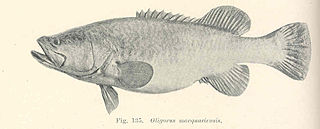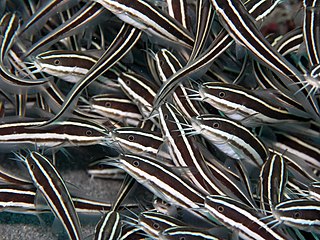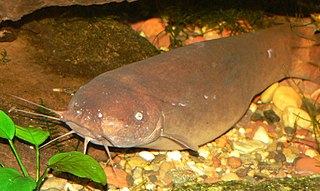
Callichthyidae is a family of catfishes, called armored catfishes due to the two rows of bony plates along the lengths of their bodies. It contains some of the most popular freshwater aquarium fish, such as many species in the genus Corydoras.

The Murray cod is a large Australian predatory freshwater fish of the genus Maccullochella in the family Percichthyidae. Although the species is called a cod in the vernacular, it is not related to the Northern Hemisphere marine cod (Gadus) species. The Murray cod is an important part of Australia's vertebrate wildlife—as an apex predator in the Murray-Darling River system—and also significant in Australia's human culture. The Murray cod is the largest exclusively freshwater fish in Australia, and one of the largest in the world. Other common names for Murray cod include cod, greenfish, goodoo, Mary River cod, Murray perch, ponde, pondi and Queensland freshwater cod.

The trout cod or bluenose cod, is a large predatory freshwater fish of the genus Maccullochella and the family Percichthyidae, closely related to the Murray cod. It was originally widespread in the south-east corner of the Murray-Darling river system in Australia, but is now an endangered species.

Loricariidae is the largest family of catfish, with 92 genera and just over 680 species. Loricariids originate from freshwater habitats of Costa Rica, Panama, and tropical and subtropical South America. These fish are noted for the bony plates covering their bodies and their suckermouths. Several genera are sold as "plecos", notably the suckermouth catfish, Hypostomus plecostomus, and are popular as aquarium fish.

The eeltail catfish are a family (Plotosidae) of catfish whose tails are elongated in an eel-like fashion. These catfishes are native to the Indian Ocean and western Pacific from Japan to Australia and Fiji. The family includes about 41 species in 10 genera. About half of the species are freshwater, occurring in Australia and New Guinea.

The golden perch is a medium-sized, yellow or gold-coloured species of Australian freshwater fish found primarily in the Murray-Darling River system, though a subspecies is found in the Lake Eyre-Cooper Creek system, and another subspecies, suspected to be ancestral to all other populations, is found in the Fitzroy River system in Queensland. Other common names for golden perch are "goldens", “yellowbelly” and "callop", the last generally used only in South Australia.

The river blackfish is a freshwater fish endemic to the temperate waters of south-eastern Australia. It is found from southern Queensland through to central Victoria, including in the Murray-Darling river system. It is also found in some eastern and southern flowing coastal rivers. Found primarily in upland and "midland" habitats, though early records of fish fauna suggest it was originally far more extensively distributed and was found in some lowland habitats as well. Originally, river blackfish co-inhabited many of its lowland and "midland" habitats with species such as Murray cod and golden perch, and its upland habitats with species such as trout cod and Macquarie perch. It is a popular angling fish in some parts of its range.

The silver perch is a medium-sized freshwater fish of the family Terapontidae endemic to the Murray-Darling river system in south-eastern Australia.

The Aspredinidae are a small South American family of catfishes also known as the banjo catfishes, with about 43 species.

Malapterurus is a genus of catfishes of the electric catfish family (Malapteruridae). It includes 18 species.

Hoplosternum littorale is a species of catfish belonging to the Callichthyinae subfamily of the family Callichthyidae. It is known as tamuatá in Brazil, atipa in French Guiana, hassa in Guyana, kwi kwi in Suriname, cascadu or cascadura in Trinidad and Tobago, and busco or currito in Venezuela.
The toothless catfish is a species of catfish of the family Plotosidae. This fish originates from northern Australia, including Fitzroy, Daly, East Alligator, Roper, Mitchell, and Archer Rivers, in lentic and lotic freshwater habitats. It grows up to about 40.0 centimetres (15.7 in) TL.
The freshwater cobbler, Tandanus bostocki, is a species of catfish of the family Plotosidae. The freshwater cobbler originates from coastal drainages of southwestern Australia, from the Frankland River to the Moore River. The species may reach about 50 centimetres (20 in) total length.
The Cooper Creek catfish, also known as the Cooper Creek tandan, is a species of catfish of the family Plotosidae, and is the only species of the genus Neosiluroides. The species’ scientific name Neosiluroides came from the genus Neosilurus to which the Cooper Creek Catfish bears some resemblance. The second part of its name, cooperensis, is a reference to the sole location of the species in the Cooper Creek Catchment. It is an eel-tailed freshwater fish that resides in the Cooper Creek system of the Lake Eyre drainage in southern Queensland, Australia. This species grows up to about 46.0 centimetres (18.1 in) SL.

Plotosus is a genus of eeltail catfishes native to the Indian Ocean, the western Pacific Ocean and New Guinea.

The bayad, is a species of bagrid catfish from Africa.
Platystacus cotylephorus, the Banded banjo, is a species of banjo catfish. It is the only member of its genus. The genus Platystacus is the sister group to a clade containing Aspredo and Aspredinichthys. P. cotylephorus originates from coastal waters and lower portions of rivers of northern South America, from Venezuela to northern Brazil.
Tandanus tropicanus or the Wet Tropics Tandan is a species of eeltail catfish native to Australia. It was discovered in rivers between Townsville and Cairns by a group of scientists from James Cook University. The species, which grows to length of about 20 inches, has a cylindrical body tapering to a thin, eel-like tail. It has small eyes and a large mouth surrounded with barbels.
Neosilurus hyrtlii, commonly known as Hyrtl's catfish or Glencoe tandan, is a species of catfish found across northern Australia, from the Pilbara to southeastern Queensland.

Neoarius graeffei, or blue salmon catfish, is a species of catfish found in freshwater rivers of Australia and Papua New Guinea. This species is most identifiable by its large, shark-like dorsal fin that is led by a poisonous spine. Like other catfish, the blue salmon catfish is known to use electrical pulses to sense prey in the water. This prey sensing mechanism may be the reason that these catfish are known to eat the land dwelling hopping mouse at a high rate.















